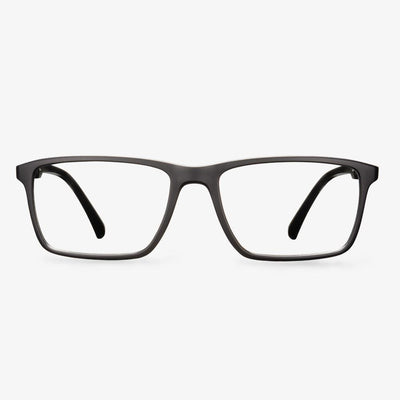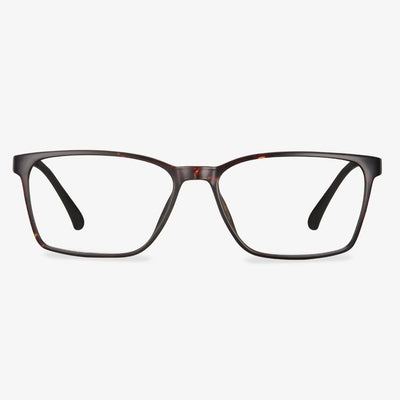The Benefits of Anti-Glare Glasses
As is well known, glare is the excessive brightness caused by direct light or reflected light. It often occurs when sunlight bounces off a reflective surface like water or snow. Of course, anti-glare glasses can also be caused by other factors.
Standard plastic lenses are able to reflect approximately 8% of the light that reaches your glasses and high-index lenses often reflect up to 12% of available light. Hence, anti-glare glasses come in a lot of advantages.
The anti-reflective glasses can reduce eye strain and make your eyeglasses look more attractive because the anti-reflective coating can eliminate reflections from the front and back surfaces of your eyeglass lenses. With this feature, more light can pass through your lenses to improve your vision with fewer distractions and the lenses look nearly invisible.
In addition, anti-glare glasses are helpful to high-index lenses, which reflect more light than regular plastic lenses. In general, the higher the index of refraction of the lens material, the more light will be reflected from the surface of the lenses.
Anti-glare glasses can protect your eyes from UV rays (sunlight that doesn’t appear on our visual spectrum). This feature can be enhanced by some photochromatic or polarized lenses.
How Long Does It Take to Get Used to Varifocals?
When you get a new pair of glasses, you have to get used to them. So, how long does it take to get used to the glasses? Some people only need a couple of days to get used to them while some others may need up to two weeks.
It is normal if you can only see the frame rim of your glasses when you first wear them. The reason for this lies in the brain’s visual center. It needs to adapt the new and greatly improved visual conditions.
Blue light blocking glasses lenses and common glasses lenses have different functions.
Blue light-blocking glasses are glasses that prevent blue light from causing irritation to the eyes. Its main function is to prevent the eyes from being affected by this light and from being irradiated. It is suitable for use in extreme working environments. Blue light-blocking glasses are not for everyone. Special anti-blue light glasses can effectively isolate ultraviolet and radiation and can filter blue light. They are suitable for use when using electronic products. And common glasses are used to improve vision, eye protection, and could solve a variety of vision problems, including myopia, farsightedness, astigmatism, presbyopia or strabismus, amblyopia, and so on.
Orthokeratology lenses are used for myopia control.
The effect of the orthokeratology lens in controlling the increase of myopia in teenagers has been unanimously affirmed by the ophthalmology industry at home and abroad. In February 2006, an authoritative ophthalmological journal published a review of the retarding effect of rigidity breathable orthokeratology lens on the progression of myopia in children. This paper reviews the literature on orthokeratology and myopia in the past 30 years and points out that rigidity breathable orthokeratology can prevent or alleviate the progress of myopia, the mechanism of which is that rigid breathable contact lens can inhibit the progress of myopia by providing clearer retinal image quality. Medium and high concentration of atropine will affect students' near-use vision, while low concentration of atropine has not been used clinically in China, so orthokeratology lens has become one of the known myopia control methods with the best statistical effect. In three to five-year case studies, orthokeratology lenses alleviate a 40 to 60 percent increase in myopia compared with wearing a frame lens or a soft contact lens. Other studies have found that 65 to 70 percent of orthokeratology lens wearers show little or no axial length increase.
The frame materials
You should choose the driver's glasses with alloy materials. The glasses made of this material are light and strong, so your ears won't be uncomfortable when you wear them for a long time.
Choose the right clear sunglasses for your face shape.
A clear eyeglass frame suits the person of different face shapes according to different shapes. For example, a heart-shaped face suits the clearest eyeglass frame, and a square face suits an elliptical transparent eyeglass frame. A round face suits the clear eyeglass frame with an outline. The long face suits the clear eyeglass frame with some width and so on. There are many kinds of clear frames, like oval, round, square frames, and so on.
When choosing clear frames, be careful to choose one that fits the shape of your face. Oval and the round clear frame are more suitable for heart-shaped faces, square faces, and long faces. People with round faces should avoid large frames, dark frames, and wide edges, and don't wear round or square frames.
Which face types are suitable for rimless glasses?
Rimless glasses are mainly suitable for round faces, heart-shaped faces, square faces, and other most face shapes. Rimless frames are designed to be light, hence, they ease the wearer's stress, increasing comfort, and providing a wide view. Rimless glasses suit most face types, suitable for people who are short-sighted within 600 degrees. If the degrees are too high, you should not wear rimless glasses. When the degrees are too high, the lens will be suitable for thickening, so rimless glasses will show bloated.


















































